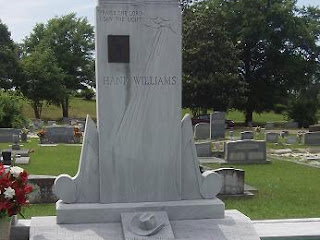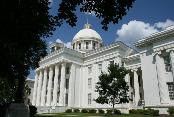| Grave of Hank Williams |
He rests today at Oakwood Cemetery Annex in Montgomery, Alabama. Buried next to his wife Audrey, Williams is memorialized by a stone monument that includes a carved representation of his trademark hat and the words "Luke the Drifter." The latter was a well-known nickname for the talented songwriter and singer.
Hank Williams was born in Mount Olive, Alabama, in 1923 and tragically lived only to the age of 29. In his sadly short life, however, he created some of the greatest American songs ever written and recorded. His sound influenced not only country music, but the rock and roll movement as well. The latter style became a firm part of the American music scene just one year after Williams' death when Elvis Presley recorded "That's All Right (Mama)." The Hank Williams sound was a major factor in the emergence of the new music form and he has been inducted into both the country and rock halls of fame.
Having taken up guitar early in life, Hank Williams first received popular acclaim when he became a regular live performer on Montgomery's WSFA Radio in 1941. When World War II ended, he made his way to Nashville where his initial contract was for only two singles: "Honky Tonkin'" and "Never Again."
| Trademark Hat in Stone |
The recording exploded to Number One on the Billboard Country & Western Chart and remained there for a stunning 16 weeks. At the same time it broke into the Top 25 of the magazine's pop chart. And when Williams performed it at the Grand Ole Opry that same year, the audience reaction was so overwhelming that he returned to the stage for a remarkable six encores.
Other hits followed, including "Why Don't You Love Me," "Cold, Cold Heart," "Kaw-Liga," "Jambalaya," "Hey, Good Lookin'," "Crazy Heart," "Honkytonk Blues" and "Your Cheatin' Heart." These and other Hank Williams songs remain standards of Country music to this day.
Ironically, the last song released before his death was "I'll Never Get Out of This World Alive." He died on January 1, 1953, in the backseat of his Cadillac as he was riding to a show in West Virginia.
To learn more about the life and career of this remarkable man and to learn about his burial place and memorial in Montgomery, please visit www.exploresouthernhistory.com/hankwilliams.











